The Heian period, which lasted from the 8 th to the 12 th centuries AD, is considered to be the last division of Japan’s classical era. This period began with the establishment of a new imperial capital at Heian-kyo (modern-day Kyoto), and ended with the founding of the Kamakura shogunate in 1185 AD.
Several new Buddhist sects were introduced into and flourished in Japan in this period. Although the introduction of these sects helped to reduce the power of the old Buddhist institutions, it did not necessarily increase the power of the imperial family. In fact, for much of the Heian period, power was held by the Fujiwara regents. The Heian period is also known for its cultural achievements and is considered to be the zenith of Japanese imperial court and aristocratic culture.
Heian-kyo, The Heian Era Capital: Built For Change
The Heian period derives its name from Heian-kyo, the imperial capital that was founded in 794 AD. Heian-kyo is today part of Kyoto and its name translates literally as “Capital of Tranquility and Peace.” Prior to the Heian period, the imperial capital was at Nara.
In 784 AD, Emperor Kanmu (also Kammu) transferred the Japanese capital to a new site, Nagaoka-kyo, a little southwest of Heian-kyo. It is believed that this move was made in order to prevent the exceedingly powerful Buddhist institutions in Nara from interfering in the affairs of the imperial government. Nagaoka-kyo, unfortunately, was prone to flooding, and hence, 10 years later, the capital was moved once again, this time to Heian-kyo.
Emperor Kanmu is regarded as one of the most powerful emperors in Japanese history. Few other emperors before and after Kanmu wielded the same amount of power and authority that he did. Kanmu was born in 737 AD and ascended the throne as the 50 th emperor of Japan in 781 AD. Apart from moving the capital to Heian-kyo, Kanmu also took several other measures to curb the power and political ambitions of the Buddhist organizations.
An edict issued by the emperor limited not only the construction of new Buddhist buildings, but also the entrance of people into monasteries, as well as the sale and donation of lands to Buddhist institutions. To further weaken the traditional Buddhist powers, Kanmu became a supporter of two new esoteric Buddhist sects: Tendai and Shingon.
New Forms Of “Safer” Buddhism Make Their Mark
Tendai, meaning “Heavenly Terrace” is a Mahayana Buddhist school that traces its origin to the Chinese Tiantai school, and is known also as the Lotus Sutra school. This is because the teachings of this sect are based on the Lotus Sutra, one of the most important sutras of Mahayana Buddhism .
Tendai was introduced into Japan by Jianzhen, a Chinese monk, during the middle of the 8 th century AD. At that time, however, the sect was not widely accepted by the Japanese. In 804 AD, Kanmu chose a Japanese monk, Saicho, who is known also as Dengyo Daishi, as an envoy to the Tang court in China, and to study at Mount Tiantai, where the Chinese Tiantai school was based.
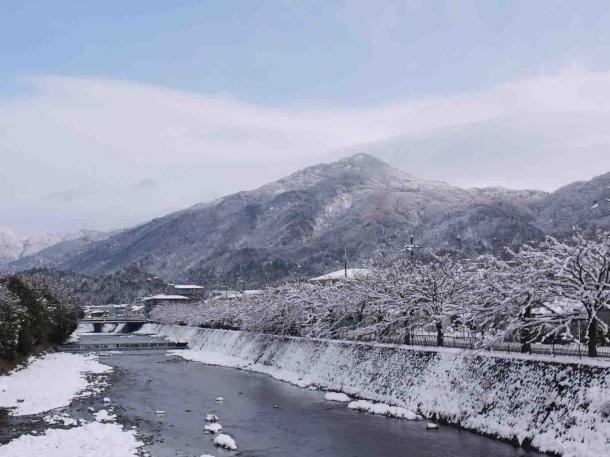
Mount Hiei, the northeastern edge of modern-day Kyoto, was where Saicho established the powerful Enryaku-ji Temple complex, one of only two monasteries in Japan during the Heian period (and beyond) that could ordain Buddhist priests. (Hahifuheho / CC0)
Having studied there for eight months, Saicho returned home with hundreds of sutras, treatises, and commentaries. The monk arrived in Japan in 805 AD, and turned Enryaku-ji, the temple he had established on Mount Hiei (on the northeastern edge of Heian-kyo or Kyoto), into the Japanese center of Tendai Buddhism. In 806 AD, Tendai was officially established by the imperial government, as one of only two monasteries authorized to ordain Buddhist priests in Japan.
Shingon Buddhism, on the other hand, means “True Word,” and is a branch of Vajrayana Buddhism that traces its origin to India. Before arriving in Japan, this sect spread from India to Tibet, and to Java and China. It is from China that this branch of Vajrayana Buddhism finally made its way to Japan. The man responsible for bringing Shingon Buddhism to Japan was a monk by the name of Kukai, known posthumously as Kobo Daishi .
In the same year that Saicho went to Mount Tiantai, Kukai left Japan for Xian, where he studied tantric practices. Two years later, he returned to Japan with many texts and art works. In the years that followed, Kukai continued to develop his own synthesis of esoteric Buddhist practices and doctrine, which were centered on the figure of the Vairocana Buddha. In 819 AD, Kukai established Kongobu-ji Temple on Mount Koya, to the southeast of present-day Osaka, which became the head temple of Shingon Buddhism in Japan.
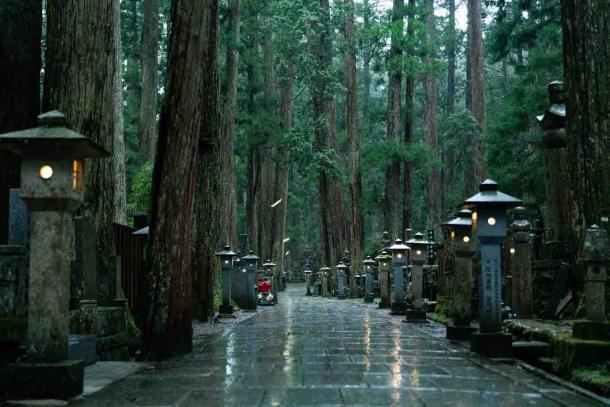
The famous Koyasan cemetery leading to the grave of Kukai or Kobo Daishi, founder of the imperial Shingon Buddhist sect, on Mount Koya. ( Claude Jin / Adobe Stock)
Although Emperor Kanmu was already dead when Kongobu-ji Temple was established, Shingon continued to receive imperial support. In 823 AD, Kukai was ordered by Emperor Saga to take charge of To-ji Temple , in Kyoto, and this temple became the new headquarters of Shingon. A year later, Kukai was appointed to the Office of Priestly Affairs, which oversaw all the Buddhist monasteries in Japan.
Both Tendai and Shingon were immensely popular during the Heian period, especially amongst the nobility. Consequently, these sects became centers of political power, as the Buddhist institutions of the Nara period had been. These temples and monasteries were able to maintain their power even after the Heian period.
For instance, in 1571, Oda Nobunaga destroyed most of Enryaku-ji Temple as part of his campaign to unify Japan. The warlord regarded the Tendai monks, which included warrior monks, as a threat to his mission.
Apart from Tendai and Shingon, another Buddhist sect that gained popularity during the Heian period was the Jodo-shu or Pure Land Buddhism , founded by Honen, who emphasized a simple faith in the Amida Buddha. The Jodo-shu sect was popular amongst the Japanese people, especially during the upheavals of the late Heian period, as its teachings provided them with solace.
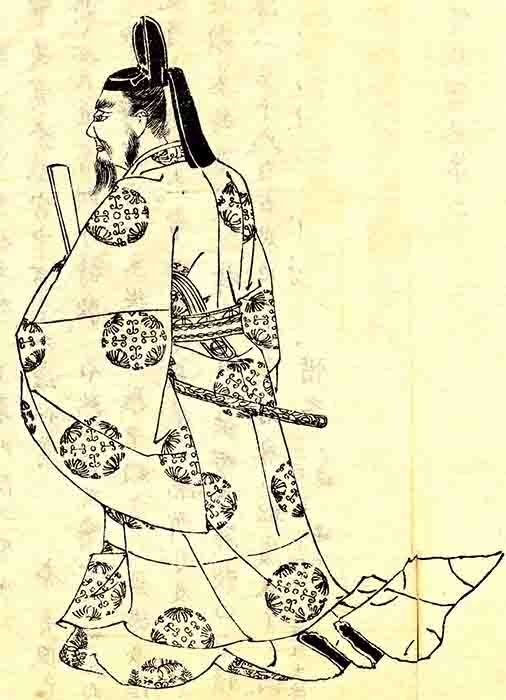
Fujiwara no Michinaga, the powerful regent, and his family “controlled” Heian-period emperors for nearly 200 years. (Kikuchi Yōsai (1781-1878) / Public domain )
The Rise Of The Imperial Regents Of The Fujiwara Clan
The Heian emperors who succeeded Kanmu were not able to wield as much power as he did. Although the emperor looked as though he was running the country, the real power was in fact held by regents from the Fujiwara clan . This clan was founded in the 7 th century AD in Nara and was able to accumulate power through marriages with the imperial family. The wife of Kanmu, for instance, was a member of the Fujiwara clan.
It was, however, only during the second half of the 9 th century AD that the power of the Fujiwara clan began to be felt. When Emperor Montoku died in 858 AD, he was succeeded by his nine-year-old son, who became Emperor Seiwa. Consequently, Fujiwara Yoshifusa, the father-in-law of Emperor Montoku, appointed himself as regent.
Yoshifusa was not only the first regent of the Fujiwara clan, but also the first regent of non-royal descent in Japanese history. To maintain their hold on the regency, the Fujiwara clan persuaded subsequent emperors to retire early. This meant that child emperors could be placed on the throne, thus allowing the Fujiwaras to continue serving as regents.
In the two centuries that followed, eight abdications and seven child emperors were recorded, a testimony to the success of the Fujiwara’s cunning policy to maintain their hold onto power. The domination of the imperial court by the Fujiwara clan reached its height in the early 11 th century, during the regency of Fujiwara Michinaga. His connections with the imperial family can be seen in the fact that three of his daughters were married to emperors, and a fourth married to an heir apparent, who later became emperor. Additionally, four of his grandsons became emperors, and, after his death in 1028, one of his sons succeeded him as regent.
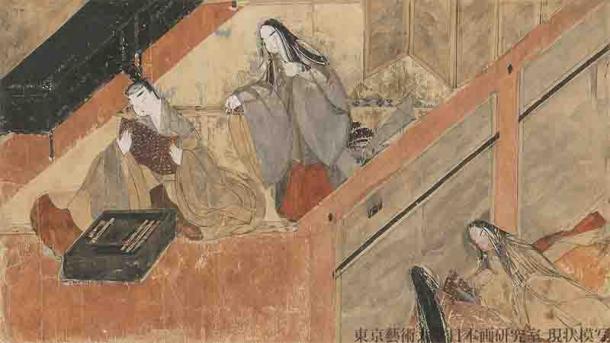
A scene from the “The Tale of Genji,” the world’s first novel, showing Yugiri reading a letter from the mother of Ochiba no Miya. Kumoi no Kari (Yugiri’s wife), who misunderstood the letter as a love letter from Ochiba no Miya to Yugiri, sneaks up from behind and tries to steal it. (Imperial Palace Kyoto / Public domain )
Cultural Achievements Of The Heian Period Aristocracy
The Heian period, more specifically, during the late 10 th century and early 11 th centuries, when the Fujiwara clan was at the height of its power, was also a time when Japanese imperial court and aristocratic culture blossomed.
One of the most notable cultural achievements of this period is the Genji monogatari , known in English as The Tale of Genji . This piece of literature was written by Murasaki Shikibu, a novelist, poet, and lady-in-waiting who lived between the 10 th and 11 th centuries. It is believed that the work was completed around 1010, and it is considered to be the world’s first novel. Although The Tale of Genji is a work of fiction, it can also be read as an introduction to the aristocratic culture of that period, as it touches upon such matters as the daily lives of the aristocratic class, the moral code they adhered to, the forms of entertainment they enjoyed, and their manner of dress.
Outside imperial and aristocratic circles, however, life for the average Japanese individual in the Heian period was not as pleasant. Although this was a period of peace, it was also a time of economic decline. The luxuries enjoyed by the elites did not trickle down to the lower classes, and it is estimated that whilst the Japanese population numbered around five million, there were only about 5000 Yokibito, or “Good People,” members of the aristocracy who enjoyed a comfortable life.
Whilst the Fujiwaras were no doubt shrewd politicians who knew how to maintain their hold on power, they were less-than-capable administrators. Consequently, the Japanese economy was mismanaged, and deteriorated as time went by. By 1000, for instance, the government no longer knew how to issue currency, and money was gradually disappearing.
One of the consequences of the mishandling of the economy by the aristocratic class was the rise of the military class. Prior to the Heian period, military conscription was controlled by the central government. In 792 AD, however, the system broke down, and the provincial elites were once again in charge of military affairs. In the centuries that followed, these provincial elites were transformed into a warrior class, or the samurai class.
This was a potential threat to the aristocrats of the central government. For instance, two serious rebellions broke out in the provinces as early as 940 AD. The Fujiwara, however, were able to suppress them with the aid of allied warrior clans. These victories increased the power and popularity of the warrior class, and the landed gentry preferred to commend their lands to this class, rather than to the Fujiwara. It seems that the Fujiwara failed to address this issue whilst they might have had the chance to do so, which ultimately led to the erosion of their power.
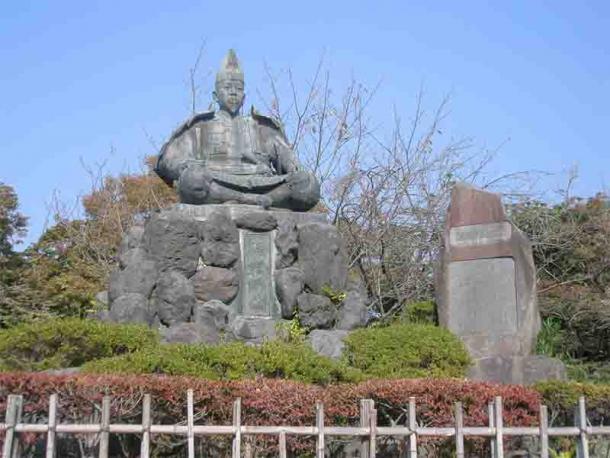
Japan’s first shogun, Yorimoto Minamoto, who established the Kamakura shogunate and the historical period of the same name that follows the Heian Period. ( 掬茶 / CC BY-SA 3.0 )
From The Fujiwara Regents To The First Shoguns
The death of Michinaga Fujiwara in 1027 led to the rapid decline of the Fujiwara clan. By the 11 th century, two other prominent aristocratic families had emerged, the Minamoto, and the Taira. Apart from that, there was some revival of imperial power.
In 1068, Emperor Go-Sanjo became the new ruler of Japan. He was the first emperor not born of a Fujiwara mother since the 9 th century AD. Although Go-Sanjo reigned for less than five years, he succeeded in weakening the Fujiwara grip on the imperial court.
Go-Sanjo’s successor, Emperor Shirakawa, instituted “insei,” or “cloistered rule,” which dealt another blow to the Fujiwara. Under this system, the emperor would abdicate, and leave an infant on the throne, as it had been under the Fujiwara regents. The big difference, however, was that the former emperor would establish a separate administration in a monastery, from where he would attempt to rule the country.
By the middle of the 12 th century, the long era of peace enjoyed during the Heian period was nearing its end. By this time, the Fujiwara clan had lost their power at court, and were replaced by the Taira clan. In 1156, the Hogen Rebellion broke out, during which there were two claimants to the throne, each supported by rival clans. The outcome of this short civil war was the ascension of Emperor Go-Shirakawa, and the control of the government by Taira no Kiyomori.
The Taira were in conflict with the Minamoto clan, and in 1180, the Genpei War was fought between these two clans. The war lasted five years, at the end of which the Taira were defeated.
The victorious Minamoto were led by Minamoto no Yoritomo, who became Japan’s first shogun. The year 1185 marks the end of the Heian period. Alternatively, 1192 is used as the year in which the Heian period ended, as it was in that year that Minamoto no Yoritomo officially became shogun of the Kamakura shogunate.
The Heian Period: Peace, Decline And Samurai Ascent
To conclude, the Heian period was indeed a long peaceful period. It is undeniable that great cultural achievements were also made by the aristocratic class who dominated the imperial court during the period.
On the other hand, it was also a period of economic decline, which facilitated the rise of powerful, local samurai clans. Ultimately, the warrior class seized power for themselves, thus establishing the first shogunate, the Kamakura Shogunate. The shogunate system would rule Japan until 1867.
Top image: Heian-jingu Shrine, Kyoto is a copy (but 33% smaller) of the original Heian-kyo imperial palace. Source: Serg Zastavkin / Adobe Stock
By Wu Mingren
References
Barton, D. W., 2017. The Heian Period: Japan’s Classic. [Online]
Available at: https://japanology.org/2017/01/the-heian-period-japans-classic/
Department of Asian Art, The Metropolitan Museum of Art, 2002. Heian Period ( 794–1185). [Online]
Available at: https://www.metmuseum.org/toah/hd/heia/hd_heia.htm
Japan Tourist Info, 2021. Heian Period Japan History. [Online]
Available at: https://www.japanvisitor.com/japanese-culture/history/heian-japan-history
Matcha Admin, 2017. The History Of Japan (Part 2) – From The Heian To Sengoku Period. [Online]
Available at: https://matcha-jp.com/en/4697
New World Encyclopedia, 2019. Shingon Buddhism. [Online]
Available at: https://www.newworldencyclopedia.org/entry/Shingon_Buddhism
New World Encyclopedia, 2020. Tendai. [Online]
Available at: https://www.newworldencyclopedia.org/entry/Tendai
New World Encyclopedia, 2021. Heian Period. [Online]
Available at: https://www.newworldencyclopedia.org/entry/Heian_Period
S. R., 2020. The Heian Period (794 to 1185) 平安時代. [Online]
Available at: https://www.japan-experience.com/to-know/the-history-of-japan/heian-period
Shinoda, M., 2019. Fujiwara Family. [Online]
Available at: https://www.britannica.com/topic/Fujiwara-family
The Editors of Encyclopaedia Britannica, 2013. Heian period. [Online]
Available at: https://www.britannica.com/event/Heian-period
The Editors of Encyclopaedia Britannica, 2020. The Tale of Genji. [Online]
Available at: https://www.britannica.com/topic/The-Tale-of-Genji
The Editors of Encyclopaedia Britannica, 2021. Kammu. [Online]
Available at: https://www.britannica.com/biography/Kammu
 RSS Feed
RSS Feed















 February 1st, 2021
February 1st, 2021  Awake Goy
Awake Goy  Posted in
Posted in  Tags:
Tags: 













